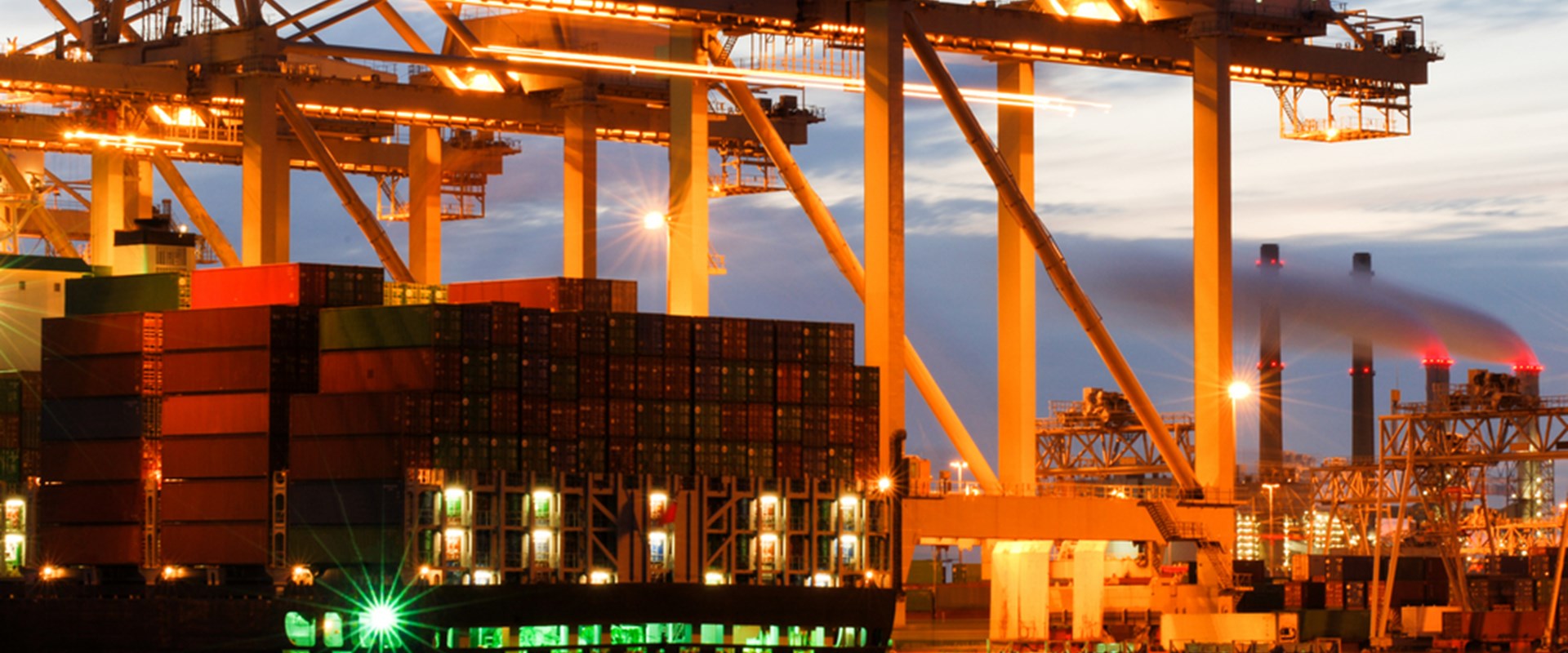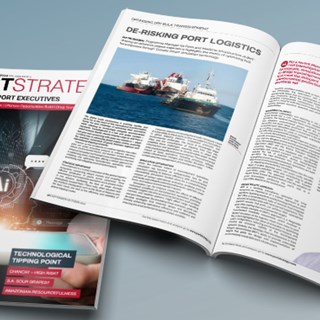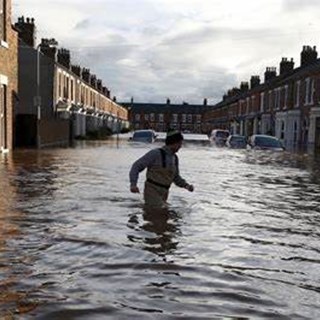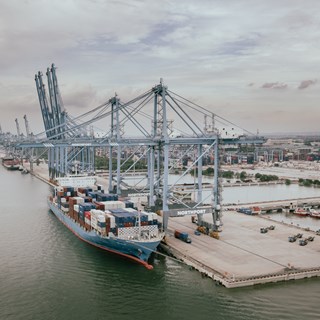
Adapt and prepare – mitigating risk for ports and harbours
Ports and harbours are a critical part of global trade-led development for the ‘Blue Economy' and provide access to international markets and supply chains.
14 March 2022
Ports and harbours are a critical part of global trade-led development, for the ‘Blue Economy’, and for providing access to global markets and supply-chains. They are integral to maritime transport, offshore energy development, fisheries, and many more essential economic activities. So, when operations at ports and harbours are disrupted, the knock-on effects are not just noticeable, they can be felt across the entire supply chain, having a significant impact not only on shipping companies but also the businesses and consumers who rely on shipping to deliver more than 90% of the world’s goods.
The impact that COVID has had on shipping operations has been noticeably acute, with shortages in personnel and logistical challenges causing significant delays to vessel operations that have since had a measurable impact on economies around the world. This has only served to highlight that, when shipping operations are impacted by outside factors, the knock-on effects can be catastrophic.
However, it’s important to consider other threats to operations that cannot be managed, predicted or controlled. As one of the most prevalent threats to operations, extreme weather can pose a number of different challenges to ports and harbours. With global emissions still at extreme levels and with little or no significant change on the horizon, it is realistic to expect that these threats will only become more frequent and more severe.
Due to their locations along open coasts or in low-lying estuaries and deltas, ports and harbours are exposed to various natural hazards including rising sea levels, storm surges, high waves, extreme winds, and riverine and pluvial flooding. Any one of these could cause severe disruption to port operations, but the reality is that port operators must prepare themselves for a combination of any number of these challenges, at any time. The potential severity of these threats to directly impact port operations will vary from port to port and will largely depend on what steps are being taken to reduce vulnerabilities and increase resilience.
As one example, port operators must consider the potential impact of increases in water levels to their infrastructure and critically, to the safety of vessels and personnel. Significant, long-term increases in water levels could cause challenges such as navigational constraints with respect to overhead clearance such as bridges, or berths becoming unusable or unsafe which then severely limits port capacity. However, adapting to changes in water levels is constrained not only by uncertainty in the predictability of the rate of sea level rise and the practicalities of replacing or updating the infrastructure, but also the lack of appropriate or endorsed engineering standards.
Another significant threat is more frequent and more severe storms. Damage to infrastructure from erosion and storm surge inundation can be extremely costly, with operators having to increase maintenance or even replace key elements of the port itself, particularly where existing coastal defence structures are old and no longer fit for purpose. More frequent and longer delays to shipping caused by extreme storm events could also have an impact on the reliability of marine shipping, with siltation rates having to increase as more frequent storms create the need for additional maintenance dredging and associated management of dredge spoil.
Furthermore, threats related to higher temperatures can create challenges not only in the water environment but also for port-side operations, with the thermal impact to paved surfaces and load bearing equipment creating the risk of equipment failures or unusable roads and railway lines, as well as the increased possibility of heat related illnesses amongst staff.
Recently, Hurricane Ida provided a stark reminder of how impactful extreme weather events can be on day-to-day port operations. Current estimates place the damage from the storm at over $95 billion, and the fallout is far from over. Ida’s direct impact on not only ports, but the many industries these ports support, was immediately evident, and we are yet to understand the full impact the hurricane will have on the ongoing supply chain crisis.
Given the critical role of ports in the global trading system and their potential exposure to climate related damage, enhancing climate resilience has now become a matter of strategic socio-economic importance. For ports and harbours, effective adaptation requires bridging potential data and knowledge gaps. This can be achieved through the development of technical solutions that deliver critical insights into the design and management of port infrastructures, and that can analyse and scrutinise every aspect of port operations to understand the impact of the full scope of potential threats. However, this awareness and understanding can be difficult and costly to obtain, unless the port has participated in a local or regional climate change vulnerability assessment or has had to consider future climate change as part of proposed expansion plans. The reality is that many impacts are not yet readily visible or understood on a local scale, and this could potentially be diminishing the lack of urgency to respond to the ever-evolving threat from climate change.
Ports can be complex operating environments with many interdependent systems delivering communications for data collection. Often, failure at any one of these data points can lead to a breakdown in communication that could leave critical personnel out of the loop and therefore unaware of any issues or challenges that could threaten operations or the safety of vessels or crews. To mitigate this, operators often install remote monitoring systems that are independent of day-to-day operating systems, however the inability of many of these systems to respond and adapt to extreme climate situations leaves a critical capability gap.
Maintaining a focus on preparedness for even the most extreme climate events is essential, and this can be achieved through advanced numerical modelling and satellite remote sensing for the offshore, shipping, and maritime engineering sectors. More advanced remote monitoring systems are able to provide detailed, critical information about the local climatology, determining the probability of occurrence of suitable weather windows, assessing the likelihood of extreme events and providing an assessment of asset performance in the marine environment, giving operators the time and valuable insights they need to duly prepare their operations.
Effective and accurate monitoring also allows operators to conduct detailed vulnerability assessments to support adaptation planning process, ensuring ports have a blueprint for future action that can be implemented over time and on an ‘as needs’ basis. Through identifying and gathering the critical information needed to inform decision making, for example assessing assets to determine their vulnerability based on their exposure and sensitivity to climate change impacts, operators can develop the essential response and management measures that will protect port infrastructure, vessels and crews.
There can be no denying that extreme weather events are already creating significant challenges for coastal zones, and with the increased likelihood that these events will intensify in both frequency and severity, these are threats which ports can no longer afford to ignore. However, effective adaptation does not need to involve major changes, significant expense or a major shift from traditional port planning processes. By taking a more balanced, risk-based approach and by bridging potential data and knowledge gaps through advanced monitoring and modelling, ports can prepare for and adapt to changing conditions. This approach will ensure that they are able to withstand, respond to, and recover rapidly from climate-related disruptions without causing significant damage to their bottom line.
Originally published in Green Port Magazine, January 2022

N/A
The DCN spoke to our climate change risk, resilience and adaptation expert about preparing for the impacts of a changing climate.

N/A
With the UK and beyond facing unprecedented consequences from rising water levels and climate amelioration, BMT are helping our clients in their need for flood alleviation, prediction, mapping and mitigation. James While talks about 5 ways we can assist our clients.

Ian McRobbie
In a Port Strategy feature, Ian McRobbie highlights the merits of optimising bulk transshipment through ‘Climate-Smart’ simulation technology, drawing on extensive project experience

Jaret Fattori
Jaret Fattori's article in Port Strategy discusses how ports are adapting to climate change and IFRS S-2 regulations. Emphasising the shift towards sustainability through digital integration, decarbonisation, and innovative fuel alternatives, he explores the significant role of collaboration in advancing port sustainability and innovation.